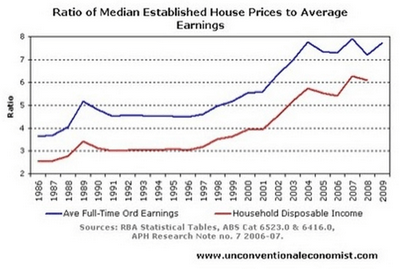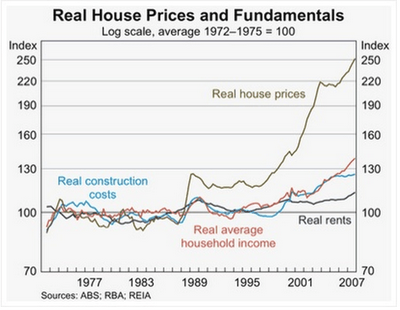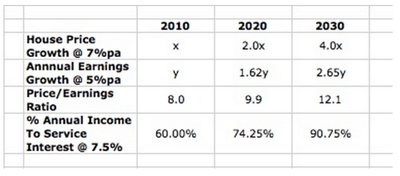Sam Birmingham runs a top quality networking site for young professionals called WeBe, which provides up-to-date information on financial matters, work-related issues, lifestyle news and reviews, and current affairs and opinion pieces. WeBe also provides a platform where members can have their voices heard, express opinions and share ideas with other like-minded Young Professionals.
Yesterday, Sam published the first in a series of articles explaining why the Australian property boom is over. Below is the first installment.
_____________________________________________________________________
Housing affordability was the most important issue in Election 2010 and the problem has only got worse, with the RBA continuing to hike interest rates. What is being done to improve housing affordability? The short answer is “bugger all”… But a rapidly-turning property market could be about to fix all that.
Despite remaining strong in the wake of the GFC, our property market is showing signs of stress.
Investors have been driven away by rising interest rates and prospective first home owners are staying on the sidelines. The Economist reckons Australia has the most over-priced houses in the world and some analysts predict falls of 30-40% over the coming years. The IMF is nervous about a developing bubble and even the head of the RBA has warned Mum-and-Dad investors that it is “a mistake to assume that a riskless, guaranteed way to prosperity is just to be leveraged up into property”.
Who is right?
As a recent article in The West Australian explained, the average loan was a mere $34,800 in 1985, with repayments taking up “only” 24% of the average wage, even though interest rates were 13.5%. Nowadays, the average mortgage has ballooned to almost $389,000 and, with interest rates at just 7.8%, the average homeowner’s monthly repayments chew up a massive 50% of their income!
Most of this declining affordability has taken place in the past 10-15 years, during which time the price-income ratio (the standard measure of housing affordability) has blown out by a factor of two. This can be seen in the graph below.
If you were ‘in the market’ over this period, you may not have minded so much, as the trend of ever-increasing prices ensured that property was a sensational investment. To get a feel for how much prices have skyrocketed, let’s compare the “real” price growth (ie. taking inflation into account), with increases in “real” incomes, rents and construction costs over the period.
While it is all well and good to look back at what has gone on in previous decades, what is more important is to look forward and try to determine whether the trend can continue…? Having gone from homes being a ‘single income, pay it back in ten years’ proposition, can we seriously expect prices to keep rising until even a dual income family has to work for thirty or more years just to pay off their mortgage?
The short answer: Not likely… Although you won’t hear that from a property spruiker – most of whom rely on claims like “there is nothing safer than ‘bricks and mortar'” and you can “expect the value of your house to double every 7-10 years”.
Does property really double every 7 to 10 years?
Wow, can property investment really be that easy? Surely not…?
Even though this exponential rate of growth might have been the case in previous years, let’s put the spruikers’ claim into action to show just how ridiculous it is:
- Are you familiar with the power of compounding and the rule of 72? If not, click this link for a quick refresher.
- Let’s take the “conservative” end of the property spruiker’s price growth spectrum; ie. assume that prices will double every 10 years, representing a compound annual growth rate of just over 7%.
- Let’s also assume that wages grow by 5% per annum (Note: In reality, wages growth is likely to be closer to 4%, but let’s be optimistic for the purposes of this exercise).
- Assume a median price-to-average annual earnings ratio of 8 in 2010, as per the graph above.
- And let’s be optimistic and pretend that you only need to pay the interest component of your loan, with an interest rate of just 7.5%…
In case your algebra isn’t too flash anymore, let me put all that into words, just to make this 110% clear…
If we assume that prices increase at the lower end of the spruikers’ range, incomes grow faster than normal, the loan is interest-only and the interest rate is a mere 7.5%, the “prices double every 7-10 years” crowd would have you believe that, in the space of just two decades, the average income earner will be devoting 90%+ of their gross income towards paying the interest on the mortgage of their median house.
And that’s before even worrying about paying taxes, buying groceries, putting fuel in the car and paying off the credit card, let alone reducing the principal of their loan… Good luck?!!
You see, that’s the problem with exponential growth which outpaces the fundmentals, such as growth in wages or growth in the economy… It can’t keep going up like that forever.
Having said all that, whilst people continue to believe that “property always goes up”, for the most part, it will – such is the importance of confidence to investment markets. As the saying goes, “a rising tide lifts all boats”. But what happens when the tide turns; when this confidence drains out of the market?
It may not have been the case since the late-1980’s, but what happens if the factors that drove the property market ever-higher for two decades have started to turn?
We’ll find out more about those factors in the follow up article next week… Stay tuned!




